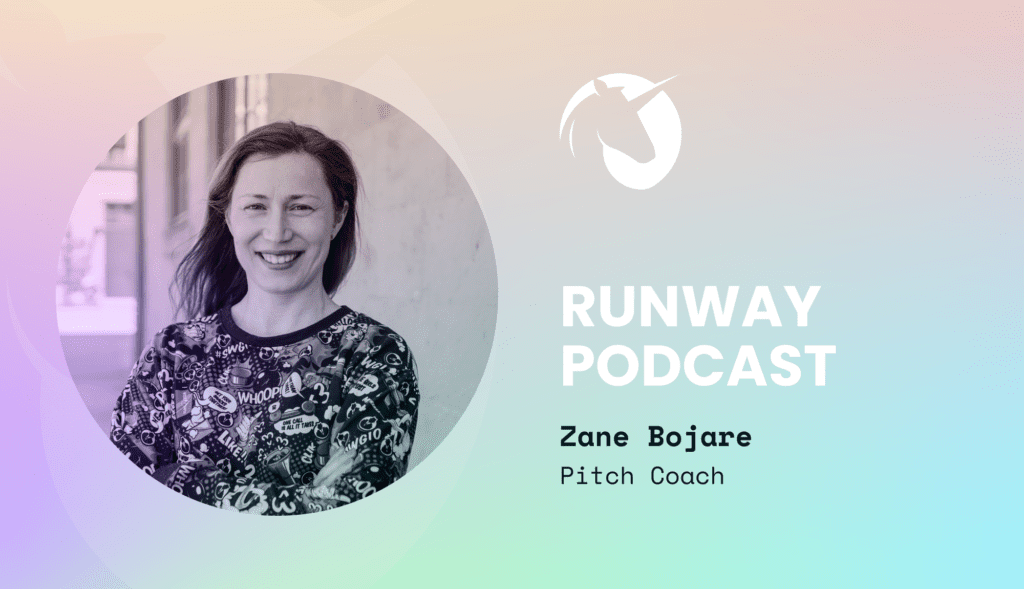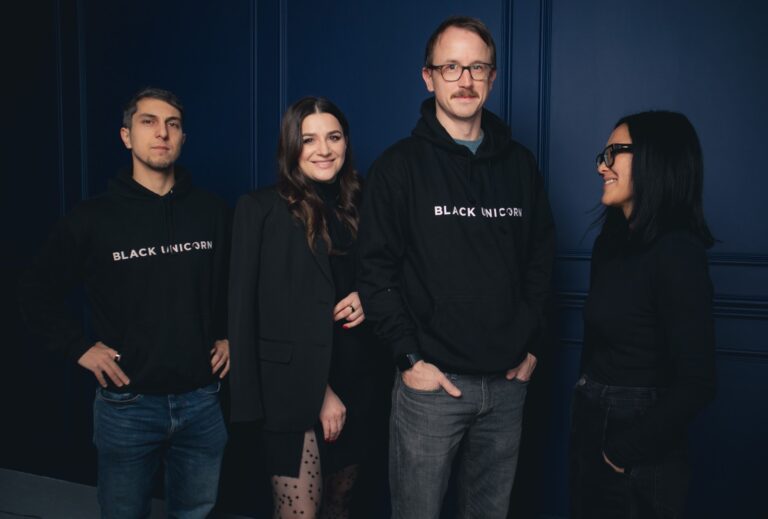In this episode of the Runway Podcast, JJ and Mauro are joined by Zane Bojare, a seasoned pitch coach who has helped over 500 founders refine their investor pitches. With seven years of experience as Head of Brand at Startup Wise Guys, seeing and helping thousands of startups going through acceleration, Zane brings a unique perspective to pitch coaching, blending storytelling with data to help founders capture investor interest.
Zane shares the art of creating a compelling pitch, balancing confidence with authenticity, and avoiding common mistakes that can derail a startup’s message. From managing stage fright to highlighting the team’s culture and drive, Zane’s insights can equip you and any founder with the skills to pitch like a pro.
Tune in and check below for the full transcript, and learn how Zane’s actionable tips can help you take your startup pitch to the next level.
Listen on Spotify
Transcript
Mauro Battellini:
Zane Bojare, for seven years, you were heading ‘brand’ at Startup Wise Guys. In my opinion, it was a time in which the company was highly successful at elevating its profile, but you decided to pursue a new passion. How did that happen? Was there one pivotal moment that inspired the change?
Zane Bojare:
That’s both a very easy and a very tough question to start with. The simple answer would be that seven years is a lot. When I entered Startup Wise Guys, I was laughing that I was coming for three months to help out, and I totally got hooked working with entrepreneurs. It’s contagious. You’re in this environment, seeing the startup founders and their daily struggles, and I was like, “Oh my god, I’m learning so much and feeling so inspired.” It made complete sense, and I couldn’t be prouder of the whole process there. My friends joke that I just had a midlife crisis. And I always say, if you consider that a midlife crisis is when you ask yourself, “Where do I see myself in 10–20 years?” then, yes, I had a midlife crisis. I was asking myself if I saw myself as a CMO or Head of Brand in ten years. The answer was no. And I think it’s both personal and professional. Marketing, especially in startups, is moving heavily into data-driven marketing—numbers, clicks, SEO, and so on. It’s great, but it has never been what brought me to marketing and communications. I’ve always been about stories. I come from PR, so I’d say I’m more of a marketing communications professional rather than pure marketing. Seeing that shift and also the needs of the company, I realized I’d done the hard work of rebranding and establishing things with my awesome team, and I felt it was time to let someone else take my place and move somewhere else.
The pitch coaching during my time at Startup Wise Guys was more of a hobby but a serious one, given the number of startups I worked with. When I looked back and analyzed what excited me most at work, it wasn’t the marketing and branding. It was the work with founders. So I thought, let’s take a break, think about it, and here I am—training startups.
Mauro Battellini:
I just wanted to paint the picture a bit more and understand what you’re doing today on a day-to-day basis and how you transitioned into this pitch coaching role.
Zane Bojare:
My days are quite packed with calls. I have two types of clients. I still work with Startup Wise Guys; I was just in Baku, Azerbaijan, training cleantech startups in a program they’re running there. So I have clients that are accelerators or incubators or various support programs. For example, I’m also mentoring startups in the EMPO Women program and always happy to do things for Riga TechGirls NGO, which is where my heart is. On the other hand, this is entirely new for me—I’ve started working with individual clients. This is something I didn’t do before, as I was working mostly with organizations.
Just to name a few clients I’ve worked with recently: I had a client doing earthquake detection through satellite data, a biotech startup building bioreactors for the pharmaceutical industry, and a female-led team from Poland creating knitted pregnancy support wear using NASA technology. It’s eclectic and crazy. And another interesting transition for me has been working with storytelling on longer speeches, not just the classic three-minute investor pitch. In September, I worked with clients preparing for longer speeches, including one client speaking at the Riga Conference on LinkedIn B2B marketing. Storytelling is a part of that, and it excites me because, in a longer keynote, the world is your oyster.
Julija Jegorova:
Considering the world is now very data-driven, how important is storytelling? How do you find that balance between telling a story and giving investors the hard numbers they want?
Zane Bojare:
The struggle is real. When you’re pitching to investors, you have to show traction, financial goals, market analysis—the boring part, but one you have to cover. For startups, specifically, I think they often get the story wrong. At least in the three-minute pitch, it’s more about the narrative and the message. If we zoom out, stories have always been central to human experience. I’m a big advocate for authenticity. Authentic stories that are raw and real are needed more now, especially in this era of generative AI, where anyone can create a story. LinkedIn, for instance, has become a weird place with all these fake stories. So, the need for vulnerable, authentic stories is increasing.
Mauro Battellini:
Yeah, so in terms of that balance, how would you describe the interplay between the story and the data side? Is it a case that startups need from the start to think about a narrative and how to package the numbers in the correct way to make it work? How should founders really think about narratives at that early stage when maybe they just had an idea, they know there’s a problem out there, a pain point for some, but how can they package it really into a story?
Zane Bojare:
That’s a kind of twofold question, and I’ll start with the latter part. I see a tendency with the very early-stage startups. Their biggest struggle is they don’t have traction yet. They ask, “How do I pitch when there are no numbers to show?” My answer is always that there’s something you can show. Investors want proof that someone wants what you’re building. It could be customer discovery, beta testers, free users, downloads—whatever it is. Don’t shy away. If an investor is reasonable, they’ll understand that you’re early in the journey. And I always tell early-stage startups to bet on the future. Build a perspective, show how you’re going to grow, what type of team you need, and how you plan to do things. Show you’re a reasonable person doing something that the world needs and that you know how to get there.
I’ll also share one little secret I’ve realized. I always invite my clients to think of a pitch as a movie trailer. Think about the last movie trailer you saw. It doesn’t summarize the movie; it piques your interest. A movie like Spider-Man can have multiple trailers based on the audience. When you’re pitching, figure out your strongest card. Is it traction? Is it disrupting an industry? Whatever it is, that’s the main message, and everything you share in the pitch should support that message. Remember, the pitch is just a trailer—it’s there to spark interest for a follow-up conversation, not to share everything at once.
Julija Jegorova:
And considering you’ve coached so many startups—from Startup Wise Guys to now—do you see any differences in pitching styles across cultures or regions? For example, is someone from Central Eastern Europe more technical and shy compared to someone from Spain who might be more flamboyant?
Zane Bojare:
Yes, there are definitely differences. I’ve worked with founders from almost all continents. I’ve noticed that female founders, regardless of culture, tend to be more humble and sometimes too respectful. They’ll downplay their achievements. And while I’m not a fan of “fake it till you make it,” I do think female founders sometimes need a confidence boost. In Estonia, for example, there are numerous strong female founders who are visible in the ecosystem, which helps a lot.
For technical founders, especially from the post-Soviet bloc, there can be a tendency to be overly modest and focus only on their home country market. Estonian founders are generally really good at packaging their ideas and telling their story with a calm confidence. Lithuanian founders, on the other hand, are more technical and may lean more into the “fake it till you make it” side. But regardless of background, I find technical founders tend to struggle with zooming out from the jargon and presenting their ideas in a way anyone can understand. They know the product deeply but need support in framing it simply.
Mauro Battellini:
So we have the story, right? Then we have the data, the numbers, but for investors, it’s often really important to understand how much energy and drive a founder has. How can a startup’s internal culture shine through in such a short pitch so investors get a sense of that founder’s resilience and energy?
Zane Bojare:
Great question! I would start by reminding you that a pitch is just one tiny piece of the interaction. If you’re pitching in a setting with many startups, you’ll most likely be remembered as “the person with the glasses who was building something scientific,” so keep it real. But it’s a good question, and I think that often founders treat the pitch as a checklist of things they need to mention—problem, solution, market, revenue, etc.—with the team usually at the end, when they’re running out of time. I suggest they put more thought into the small things: how they present, their attitude, and even the design of the slides. These details say a lot about a company’s culture. For example, I always recommend using photos instead of digital images or icons because our eyes perceive them differently.
And while many founders list team members’ résumés or CVs at the end, I think there’s a huge opportunity to bring that culture element in on the “Team” slide by using a team photo or sharing a quick anecdote about how they work together. Early-stage investors are investing in the team as much as in the product, if not more. If you have worked together before, or if you’ve built something together successfully, it’s a huge green flag. Showcasing how your culture aligns with your mission can resonate powerfully.
Julija Jegorova:
You touched on an interesting point about mistakes. What common mistakes do you see founders making when pitching, and how can they avoid them?
Zane Bojare:
I’d say one major mistake is what I call the “expert pitch,” where founders assume their audience knows as much about their field as they do. This is particularly common with medtech, deep tech, and cybersecurity startups. I remind founders that, while they might sometimes pitch to experts, it’s rare, maybe 5% of the time. They need to learn how to tell their story simply and in a way that anyone—potential customers, investors, or even a child—could understand.
Another common issue is a lack of narrative or bigger message. Often, founders just list things off—a problem, a solution, a team—with no connection between them. It becomes just ticking boxes, which is pretty basic and unlikely to be memorable. Running out of time is another frequent problem, especially in pitch competitions where you might be cut off harshly. I advise founders to aim for two minutes and forty seconds if they have three minutes, leaving a buffer for any issues.
Finally, founders often forget that different audiences need different pitches. Investors care about the product’s long-term viability, while clients just want assurance that the company won’t go under right after they buy in. Tailoring the pitch to the audience shows thoughtfulness and adaptability.
Julija Jegorova:
You mentioned that pitching is like a theater play or a performance. It’s true that going on stage, be it in front of 15 people or 500, can be nerve-wracking. What do you recommend for founders who get nervous or anxious before a pitch?
Zane Bojare:
Great question, and one I can relate to personally—I still get nervous before going on stage. But a bit of nervous energy is natural. I like to think of it as adrenaline that helps focus. It’s worth noting that excitement and anxiety feel the same physically, and the difference is in how we interpret it. Sometimes just labeling that feeling as excitement can help.
For those who have really paralyzing fear, I’d recommend speaking to a professional, especially if there’s past trauma involved. For most people, though, a few techniques can help. First, take care of your body: get enough sleep, eat well, and exercise. Exercise can be great on the day of the pitch since stress is physical. When we were onsite at Startup Wise Guys, we’d make founders do planks and jumps before a pitch to release some of that energy.
I also suggest knowing what works for you personally. Some people like upbeat music to pump themselves up, while others prefer something calming. Visualizing the first and last 15 seconds of the pitch is another technique, as is deep breathing. A simple rule: if you need to calm down, make your exhale longer than your inhale. Techniques like these are great for grounding yourself right before stepping on stage.
Mauro Battellini:
Thank you so much. This has been a wealth of information, from best practices to common mistakes to handling anxiety. It’s been like a masterclass in pitching! I’m sure we’ll need a part two, but in the meantime, how can people follow you and get in touch? Do you have any interesting projects coming up?
Zane Bojare:
I’m like the shoemaker with no shoes, coming from branding and marketing but with no website just yet. For now, the best way to reach me is on LinkedIn. I’m happy to connect with people and chat there. And since you asked, I’ve just launched a new project with my former colleague from Startup Wise Guys, Karina Lapina. It’s called Enabler School, and it’s aimed at offering mini crash courses for early-stage startup founders.
We’ve just launched our first course, “Pitch and Rise Drills.” It’s not your typical course; it’s all about drills. Startups come in, give a quick pitch, and get actionable feedback. It’s perfect for those who need a quick fix and can work independently. For more comprehensive work, I still offer packages with more sessions, but Pitch and Rise Drills is affordable and great for founders who just need that extra nudge.
Mauro Battellini:
Perfect! Sharing the knowledge is what it’s all about. Thanks so much for your time, Zane Bojare. It’s been great having you.
Zane Bojare:
Likewise. Thanks, Mauro and Julija. Bye!
Can’t get enough of the Runway pod? Check out these other episodes:
When Comms Meets Venture Capital, with Elisheva Marcus, VP Comms at Earlybird VC
Matthew Thompson, Director Sales Development EMEA at Deel: Running and Scaling Inbound Sales
Eric Melchor, founder of B2B PodPros on running and advertising on podcasts
The Ins and Outs of LinkedIn for Startups with Kotryna Kurt
Affiliate Marketing 101 with Vik Ratomske of Partnergap
Adam Jennings on the foundations of branding
Silicon Valley veteran Gregory Kennedy on B2B startup marketing
Robin Wauters on European tech, the business of media and AI
Ex-Fortune editor Jake Meth on planning, writing and pitching the perfect op-ed




